
Scholars from the National Institute for Japanese Literature (NIJL), one of Japan’s most premier humanities research institutes, and the Honolulu Museum of Art (HoMA) trekked to the University of Hawaiʻi at Mānoa in August to mark their seven-year long partnership with the university and also welcomed Hamilton Library’s newest resource, a 16th century handwritten kansubon (scroll) authored by Japanese poet Asukai Yoritaka. The 30-poem sequence, “Ei sanjusshu waka,” is considered a treasure for its whimsical use of auxiliary verbs and phrases.
“By tracing the scroll’s journey from medieval Japan, through various hands, to its current location in the Hamilton Library, we’re reminded of the power of literary artifacts and their ability to inspire across generations and geographical boundaries,” said Pier-Carlo Tommasi, a professor in UH Mānoa’s East Asian Languages & Literatures Department (EALL).
Yoritaka’s poetry is part of Tommasi’s curriculum in his Introduction to Classical Japanese course where students delve deeply into waka (poem) translation. Tommasi played a key role in organizing a three-day workshop series which showcased talks from distinguished researchers at UH Mānoa, NIJL and HoMA on Japanese literature.

UH Mānoa PhD student Zi “Chelly” Ye was among the event’s presenters on August 28 and focused on how Yoritaka’s waka sequence gives readers a glimpse into his imaginative world
She meticulously translated poems two and nine, which spotlight the fragrance of ume (plum) blossoms and finding coolness in summer.
Yuki no naka no uguisu (Warblers in the snow)
ume ga ka no (Awaiting the fragrance of plum blossoms)
saku o ososhi to (That are late blooming)
uguisu no (This early morning)
kesa wa mazu nuu (The impatient warblers started weaving)
yuki no hanagasa (A sun hat of snow!)
“I quickly discovered that analyzing waka poetry requires the same skill sets for good historical research,” said Ye. “One has to carefully scrutinize canonical works and directories of kakekotoba (pivot words) and utamakura (place names) for hints and clues before one can make hypotheses about the meanings of each word and finally explain the whole story.”
Scholars from NIJL were particularly impressed with Ye’s dissection of the waka entries. Hajime Kawakami, an assistant professor at NIJL, spent a couple weeks as a visiting scholar at UH Mānoa EALL and was sitting in the audience during Ye’s presentation.
“Her analysis was anchored in rigorous philological methodology, demonstrating a profound grasp of poetic themes and aesthetics,” said Kawakami. “Her thorough examination of prior works and nuanced translations reaffirmed the impressive caliber of Japanese literary studies overseas. I can see a bright future for this field at UH Mānoa and am deeply grateful for the opportunity to contribute to and learn from such a vibrant academic community.”

The workshop series concluded with a dinner reception at the Consulate-General of Japan in Honolulu. This year’s NIJL–HoMA–UH Mānoa delegation visit was sponsored by the Center for Japanese Studies, the EALL Japanese Language and Literature fund and Hamilton Library.
EALL is housed in the UH Mānoa College of Arts, Languages and Letters.

